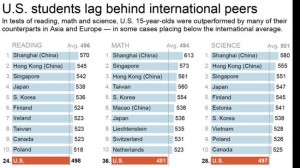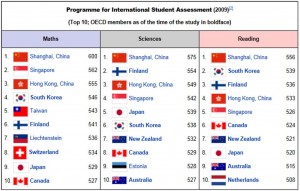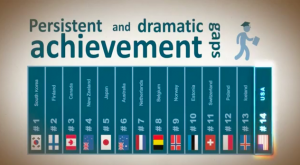
What can we learn from the PISA Results
PISA Results and the Lessons We can Learn
As we compare US Students to the rest of the world’s learners, we have a set of metrics we can use to see how different educational systems measure up against each other. This is the PISA. The idea is to test what 15 year olds know, and what they can do with what they know.
Listen to this post!
Here are the results for the United States. Among the takeaways:
- While the U.S. spends more per student than most countries, this does not translate into better performance. For example, the Slovak Republic, which spends around USD 53 000 per student, performs at the same level as the United States, which spends over USD 115 000 per student.
- The United State is below average in Math, and close to average in reading.
- The United States is behind particularly in real-world application of math, and the PISA notes that implementation of the Common Core Standards will help bring this up.
- The United States has not made any gains in this test over time.

WHAT DO POLAND, FINLAND AND SOUTH KOREA HAVE IN COMMON?
 Not much on the face of it. But all three countries had their kids make dramatic gains on the PISA test. This test is designed to evaluate how well 15 year old kids around the globe can think and solve problems. The test is indeed more demanding than multiple guess tests, at least at a higher level where you have to write in an answer. It does require some thought, and it could easily have some cultural biases built in, as some critics have charged.
Not much on the face of it. But all three countries had their kids make dramatic gains on the PISA test. This test is designed to evaluate how well 15 year old kids around the globe can think and solve problems. The test is indeed more demanding than multiple guess tests, at least at a higher level where you have to write in an answer. It does require some thought, and it could easily have some cultural biases built in, as some critics have charged.
Sample questions can be found at http://pisa-sq.acer.edu.au/ or http://www.oecd.org/pisa/test/ (math only)
WHY DOES THE PISA MATTER?
 Test results are highly relevant from an economic perspective because, as Amanda Ripley writes in The Smartest Kids in the World, “economists have found an almost one to one match between PISA scores and a nation’s long term economic growth…if the United States had Finland’s PISA scores, GDP would be increasing at the rate of one to two trillion dollars per year.” That’s a lot of money.
Test results are highly relevant from an economic perspective because, as Amanda Ripley writes in The Smartest Kids in the World, “economists have found an almost one to one match between PISA scores and a nation’s long term economic growth…if the United States had Finland’s PISA scores, GDP would be increasing at the rate of one to two trillion dollars per year.” That’s a lot of money.
So here’s what the countries have in common:
- They take education seriously. Academic achievement is highly valued by parents and students. Schools exist for academic achievement. They don’t exist to play football, nor do they exist to serve social functions such as feeding kids and providing shelter, as our schools do.
- There is a culminating high stakes test in HS that is high stakes for the kids, more so than for the high school or the school system itself. Our testing regime is high stakes for schools, but not for kids.
- Teaching is a much more selective occupation. In our country, a much broader range of academic achievement qualifies you to be a teacher; in other countries you have to be a top academic performer. Teachers are paid better in other countries, but they have larger classes to keep costs down.
- Parental involvement matters, but it’s about reading to younger children, discussing the news with older kids, quizzing them on their homework. It’s not about helping with the bake sale, showing up at football games or even helping to coach them, being involved with the PTA or complaining about the bad grades your child has earned.
- Kids who need help get it early, and with greater resources. That’s not how we do it here, as we know. The US is one of only four countries where poorer performing kids have fewer resources than higher performing ones. One of the other countries on this list, Israel, is there by virtue of its incredibly complicated system of multiple public school systems where it subsidizes religious schools. Think if we in NY subsidized the Catholic school system and the Jewish yeshivot enough so that the parents didn’t have to pay anything for their children to attend them, but didn’t give them as much money as we give public schools. That’s Israel.
Here’s some things that don’t correlate with PISA success
 Overall spending levels. Countries with high success rates simply aren’t spending more, nor are countries doing poorly spending less.
Overall spending levels. Countries with high success rates simply aren’t spending more, nor are countries doing poorly spending less.- Technology in the classroom. Absolutely no correlation with success. All those fancy and expensive smartboards that fill at least suburban classrooms? No difference to outcomes.
- Cultural uniformity. South Korea, Poland and Finland seem pretty homogenous, especially compared to the melting pot that is NYC. But in an area of Helsinki, Finland, 1/3 of the kids are immigrants, many of them refugees. They included Africans, Albanians and Chinese. These kids were actually outperforming their Finnish peers. (Ripley pp. 160ff)
Ripley’s conclusion is that rigor and high expectations matter above all. If we demand and expect that our children will learn, and we give them a very concrete, high stakes evaluation, then learn they will.
 Now, there’s something interesting in the results that jives with my experience in Japan. No one in Korea thinks that their system, an insane pressure cooker approach, featuring school, more school and after dinner tutoring until 11PM is desirable.
Now, there’s something interesting in the results that jives with my experience in Japan. No one in Korea thinks that their system, an insane pressure cooker approach, featuring school, more school and after dinner tutoring until 11PM is desirable.
I remember seeing Merry Christmas, Mr Lawrence, a movie written and directed by Nagisa Oshima about a POW in Japanese war camps during WWII. At one point, a camp guard says to David Bowie’s character that the Japanese couldn’t go insane individually, so they went insane collectively. Part of that was a response to a long tradition of a pressure cooker approach to learning (driven in part by the complexities of learning to read Japanese, but I digress even further). So we shouldn’t conclude that if we only copied South Korea, or Finland or Poland, everything would be hunky dory. But their results, and our mediocre results combined with the common complaints about the level of reasoning ability of our grads, should give us pause to reflect on our system.
For further reading, on what the PISA Results mean, check out the always thoughtful ASCD’s Whole Child Blog which focuses on takeaways relating to socioeconomic status. The PISA results show correlations between a student’s socioeconomic status and indicators like school climate, discipline, attendance, grade repetition, and resources. This post breaks that down into interesting quotes from the report.
Jared Gellert is the executive director for the Center for Integrated Training and Education .
For a weekly email featuring NYC DOE news, Classroom tips, and course offerings, please sign up here.
If you found this useful, please share it!

